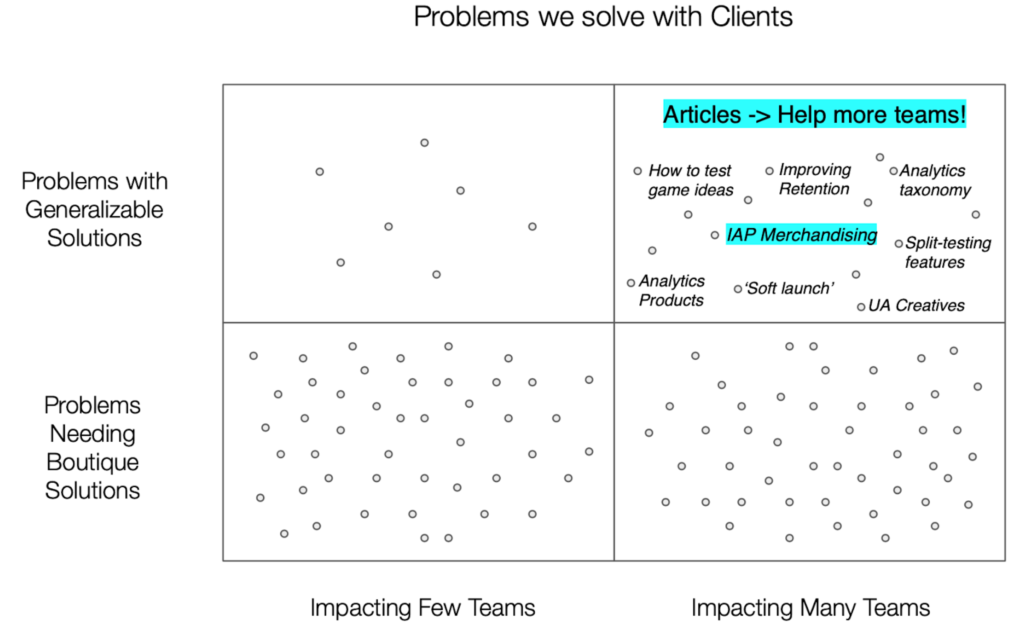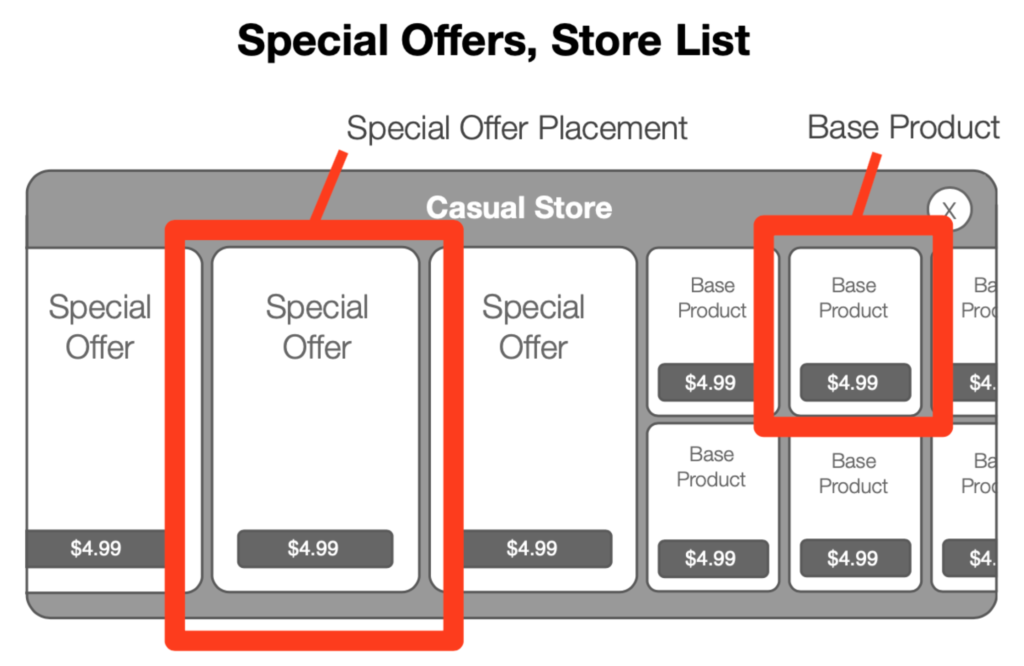
About our articles and guides
In our work on 80+ games with 35+ game teams, there are some challenges that we encounter again and again. Over time, our experiences naturally evolve into generalizable best-practices.
In my articles, I strive to document these best-practices and make them available to everyone!, not just the few core clients that we serve.

Above: How we think about these articles. Let us know which topics most interest you!
About this article
In THIS article series I will focus on IAP Merchandising, an area where best-practices are particularly tangible, well-established, and almost certain to get you the best results!
And yet, these best-practices don’t seem to be documented anywhere… let’s fix that.
If the term ‘IAP Merchandising’ is unfamiliar to you, I’d recommend you first skim: ‘What is IAP Merchandising?’
If you follow the recommendations that follow, your team can save time and effort while avoiding the most common mistakes. Perhaps, like us at Turbine Games Consulting, you’ll even come to regard IAP Merchandising, and IAP Monetization more broadly, as one of the ‘easier’ parts of F2P game development.
Now, I certainly don’t mean to suggest that effective merchandising requires NO effort. Art assets still need to be created, stores wireframed, products designed, discounts tested and so on. But if we follow a playbook, effort and results are fairly predictable, with few surprises along the way!
Why start this series with Special Offers?
Opening our IAP Merchandising discussion with Special Offers helps us focus first on the fundamentals: how to most effectively present a single product to your players. Later in this article series, we’ll zoom out and tackle broader, structural topics like store layout, segmentation and discounts.
Let’s get started!
Best Practice #1: Special Offers should be ‘Captivating’
Offers have one job
If we expect our players to exchange real money for virtual (read: NOT REAL) products, we’d better do everything we can to make them look and feel valuable!
In your battle to captivate players via IAP merchandising, special offers are the most powerful tool in your arsenal. While your vanilla, in-store base products must also convey value, special offers have a higher calling: to be irresistable. The most effective offers evoke palpable feelings of excitement, opportunity, urgency and loss-aversion.
Many games miss the mark here.
When they do, a common cause is the developers’ failure to internalize and match the standard of quality set by their top-grossing competitors. The most egregious merchandising I’ve seen came from teams who didn’t habitually analyze top-grossing games.
This is an unnecessarily risky choice, because players’ perception of value is the primary driver of their monetization decisions, and this perception is regulated by the games they play most often.
So, your IAP products need to look as appealing as your top competitors’.
Two Types of Special Offers
The two most common places (“placements”) where special offersare sold, are:
In-Store Product List
Modal Popup Banner
In-Store Product List Offers
The In-Store Product List presents special offers next to basic products, facilitating the side-by-side comparisons that drive urgency.

Above: in the scrollable, in-store product list, medium banners are used to elevate and differentiate ‘special offers’ from the smaller, gridded ‘base products.’ This store layout is ubiquitous for games across the Casual — Core spectrum.
Modal Popup Offers
The Modal Popup (or ‘screen takeover’) is the second place where special offers are merchandised.

A modal popup puts the interface into a ‘mode’ where the main window, while still visible in the background, has its functionality and buttons temporarily disabled. The popup becomes the front window and has the focus.
In F2P Games, modal popups generally occupy two-thirds of the screen. This provides enough room to make a captivating pitch for your IAP product while still leaving some background visible for context.
Your Checklist for Creating ‘Captivating’ Special Offers
“Your IAP products need to look as appealing as your top competitors”.
This gets us in the ballpark but, as a measurable standard, it still falls short for two reasons:
‘As appealing as’ is still uncomfortably subjective
We should aim for better than ‘appealing!’ I’d say: ‘captivating.’
So, we’ll enumerate 7 key criteria for ‘Captivating’ Special Offers.
Here is your checklist:
Mandatory:
Generous size: To effectively communicate that they are special, special offers need significant screen real-estate. For modal pop-ups, use at least 2/3 of the screen. In the scrollable store, use ‘medium banner’ or larger size.
Killer Hero Image: A special offer product should have a large, beautiful key art asset that makes the offer feel exciting and aspirational. This is often dubbed the ‘Hero Image’ (meaning ‘important image’, not ‘image of a hero’).
Retina-quality art assets: Do NOT over-compress your offer assets. They should appear fully retina resolution, with crisp edges, and no visible distortion.
Uncluttered: Having too much text, too many distinct visual elements, or inadequate margins creates visual clutter that detracts from both the clarity of your pitch and the perception of product value. This is a big personal pet peeve of mine!
Effective Visual Hierarchy: The user should consume information in the correct order, most important to least, to minimize friction and effort. For most offers this means allowing the product title, purchase button, and hero image to carry the show, while making other elements smaller in size and lower in contrast. We’ll explore Visual Hierarchy in-depth in the next article!
Optional Bonus:




































